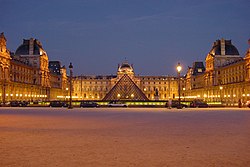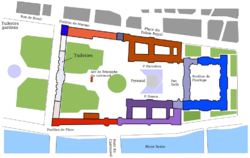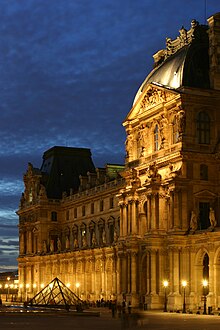Louvre
 | |
 | |
| Established | 1793 |
|---|---|
| Location | Palais Royal, Musée du Louvre, 75001 Paris, France |
| Visitors | 7,300,000 (2005) |
| Director | Henri Loyrette |
| Website | www.louvre.fr |
The Louvre Museum (Musée du Louvre) in Paris, France, is the largest museum in the world. Built as a fortified royal palace for Philip Augustus in the centre of Paris and in the axis of the Champs-Élysées, parts of it were first opened to the public as a museum on November 8, 1793, during the French Revolution. The central courtyard, occupied by the Louvre Pyramid built in 1989, serves as the main entrance to the museum.
The museum is famous for holding several of the world's most prestigious works of art, such as Leonardo da Vinci's Mona Lisa, The Virgin and Child with St. Anne, Virgin of the Rocks and Alexandros of Antioch's Venus de Milo.
In 2005, the Louvre received a record 7.3 million visitors in part due to the success of Dan Brown's 2003 novel The Da Vinci Code[1]—a significant boost of 22% compared to previous figures, placing the Louvre as the most visited monument in Paris.[2]
Construction and architecture

The first royal "Castle of the Louvre" was founded by Philip Augustus in 1190, as a fortress to defend Paris on its west against Viking attacks. In the 14th century, Charles V turned it into a palace of the arts, but Francois I and Henri II tore it down to build a real palace; the foundations of the original fortress tower are now under the Salle des Cariatides (Room of the Caryatids).
The existing part of the Châteaux du Louvre was begun in 1535. The architect Pierre Lescot introduced to Paris the new design vocabulary of the Renaissance, which had been developed in the châteaux of the Loire. His new wing for the old castle defined its status, as the first among the royal palaces. J. A. du Cerceau also worked on the Louvre.
During his reign (1589-1610), King Henry IV added the Grande Galerie. More than a quarter of a mile long and one hundred feet wide, this huge addition was built along the bank of the River Seine and at the time was the longest edifice of its kind in the world. Henry IV, a promoter of the arts, invited hundreds of artists and craftsmen to live and work on the building's lower floors. This tradition continued for another 200 years until Napoleon III ended it.

Louis XIII (1610-1643) completed the Denon Wing, which had been started by Catherine Medici in 1560. Today it has been renovated, as a part of the Grand Louvre Renovation Programme.
The Richelieu Wing was also built by Louis XIII. It was part of the Ministry of Economy of France, which took up most of the north wing of the palace. The Ministry was moved and the wing was renovated and turned into magnificent galleries which were inaugurated in 1993, the 200th anniversary of the Louvre Museum.
Commissioned by Louis XIV, architect Claude Perrault's eastern wing (1665-1680), crowned by an uncompromising Italian balustrade along its distinctly non-French flat roof, was a ground-breaking departure in French architecture. His severe design was chosen over a design provided by the great Bernini, who came to Paris for the purpose. Perrault had translated the Roman architect Vitruvius into French. Now Perrault's rhythmical paired columns form a shadowed colonnade with a central pedimented triumphal arch entrance raised on a high, rather defensive basement, in a restrained classicizing baroque manner that has provided models for grand edifices in Europe and America for centuries. The Metropolitan Museum in New York, for one example, reflects Perrault's Louvre design.
Napoleon I built the Arc de Triomphe du Carrousel (Triumph Arch) in 1805 to commemorate his victories and the Jardin du Carrousel. In those times this garden was the entrance to the Palais des Tuileries.
The Louvre was still being added to by Napoleon III. The new wing of 1852-1857, by architects Visconti and Hector Lefuel, represents the Second Empire's version of Neo-baroque, full of detail and laden with sculpture. Work continued until 1876.

Louvre Pyramid
Louvre Pyramid is a large glass pyramid commissioned by then French president François Mitterrand, designed by Ieoh Ming Pei and was inaugurated in 1989. This was the first renovation of the Grand Louvre Project. The Carre Gallery, where the Mona Lisa was exhibited, was also renovated. The pyramid itself reaches a height of 20.6 metres (about 70 feet); its square base has sides of 35 metres (115 feet). The pyramid covers the Louvre entresol and forms part of the new entrance into the museum.
La Pyramide Inversée
The La Pyramide Inversée is a skylight constructed in an underground shopping mall in front of the Louvre. It may be thought of as a smaller sibling of the more famous Louvre Pyramid proper, yet turned "upside down": its upturned base is easily overlooked from outside.
The pyramid marks the intersection of two main walkways and orients visitors towards the museum entrance. Tensioned against a 30-ton, 13.3-meter square steel caisson frame, the inverted pyramidal shape in laminated glass points downward towards the floor. The tip of the pyramid is suspended 1.4 meters (a little more than 4.5 feet) above floor level. Individual glass panes in the pyramid, 30 mm thick, are connected by stainless steel crosses 381 millimeters in length. After dark, the structure is illuminated by a frieze of spotlights.
Future projects
Le Louvre-Lens
Since a large part of the works in the Louvre are in storage, it was decided that an extension to the Louvre was to be created to the north of Paris. The project should be completed by 2009; the building will be capable of receiving between 500 and 600 major works. This new building should receive about 500,000 visitors per year. There were six city candidates for this project: Amiens, Arras, Boulogne-sur-Mer, Calais, Lens, and Valenciennes. On November 29, 2004, French Prime Minister Jean-Pierre Raffarin chose Lens, Pas-de-Calais to be the site of the new Louvre building. Le Louvre-Lens was the name chosen for the museum.
The new building, under the administration of the Regional Council of Nord-Pas-de-Calais will have semi-permanent exhibition space covering at least 5000 m². There will also be space set aside for temporary national and international exhibitions. The building will be a group of glass and aluminum buildings in the middle of a large garden. The estimated cost for this building is 117 million euro, or 158.7 million US dollars (as of January 2005). It was confirmed on September 26, 2005 with the Japanese office of architecture that SANAA, under the auspices of Kazuyo Sejima and Ryue Nishizawa, will be designing the building.
Access
The station is named after the nearby Palais Royal and the Louvre. Until the 1990s its name was Palais Royal; it was renamed when a new access was built from the station to the underground portions of the redeveloped Louvre museum.
| Located near the Métro stations: Palais Royal - Musée du Louvre and Louvre Rivoli. |
The Museum

The Louvre holds works of art through till 1848. Later works are shown at the Musee d'Orsay and contemporary art is at Pompidou Centre
Long managed by the French state under the Réunion des Musées Nationaux the Louvre has recently acquired powers of self-management as an Etablissement Public Autonome (Government-Owned Corporation) in order to better manage its growth. Since September 14, 2005, the Louvre museum has gradually forbidden the taking of photos of its artworks.[3]Signs prohibiting photography suggest the consultation of the images on the Louvre online catalog instead.
Among the thousands of priceless paintings is Leonardo da Vinci's Mona Lisa, probably the most famous painting in the world, housed in the Salle des Etats in a climate-controlled environment behind protective glass. Works of artists like Fragonard, Rembrandt, Rubens, Titian, Poussin, and David can also be seen. Among the well-known sculptures in the collection are the Winged Victory of Samothrace and the Venus de Milo.
The collection of Baron Edmond de Rothschild (1845-1934), given to the Louvre in 1935, fills an exhibition room. It contains more than 40,000 engravings, nearly 3,000 drawings and 500 illustrated books.
Besides art, the Louvre has many other types of exhibits, including archeology, history, and architecture. It has a large furniture collection, whose most spectacular item used to be the Bureau du Roi of the 18th century, now returned to the Palace of Versailles.
Notable works
Famous artworks in the Louvre include:
Notable paintings
13th to 15th century
- The Madonna and Christ Child enthroned with angels, Cimabue (about 1270)
- Saint Francis of Assisi receives the stigmata, Giotto (about 1290-1300)
- Portrait of John II the Good, anonymous (about 1350). Acquired by Louis XV, part of the royal collection
- The Virgin with Chancellor Rolin, Jan van Eyck (about 1435). Seized in the French Revolution (1796)
- Portrait de Charles VII, Jean Fouquet (1445-1448). Bought in 1838
- The Condottiero, Antonello da Messina (1475). Bought in 1865
- St. Sebastian, Andrea Mantegna (1480)
- Ship of Fools, Hieronymus Bosch (1490-1500)
- Self-Portrait with flowers, Albrecht Dürer (1493). Bought in 1922
16th century
- Mona Lisa, Leonardo da Vinci (1503-1506), acquired by Francis I in 1519
- The Virgin and Child with St. Anne, Leonardo da Vinci (1508)
- The Virgin and Child with Saint John the Baptist, called la Belle Jardinière, Raphael (1508). Belonged to the royal collection, acquired by Francis I
- Portrait of Balthazar Castiglione, Raphael (about 1515), acquired by Louis XIV from the estate of Mazarin
- The Wedding at Cana, Paolo Veronese (1562-1563). It hung 2.5 metres from the floor in the San Giorgio Maggiore monastery for 235 years, until it was plundered by Napoleon in 1797
17th century
- Saint Joseph charpentier, Georges de la Tour (1642), donated in 1948
- The club foot, Joseph de Ribera (1642), bequeathed in 1869
- The pilgrims of Emmaus, Rembrandt (1648), seized in the French Revolution in 1793
- Le young mendicant, Murillo (about 1650), bought by Louis XVI about 1782
- Bathsheba at Her Bath, Rembrandt (1654, bequeathed in 1869
- Ex Voto, Philippe de Champaigne (1662), seized in the French Revolution in 1793
- The Lacemaker, Johannes Vermeer, (1669-1670), bought in 1870
- Et in Arcadia ego, Nicolas Poussin (1637-1638)
18th century
- Portrait of Louis XIV, Hyacinthe Rigaud (1701)
- The Embarkation for Cythera, Antoine Watteau (1717)
- La Raie, Jean-Baptiste-Siméon Chardin (before 1728)
- Oath of the Horatii, Jacques-Louis David (1784)
- Master Hare, Joshua Reynolds (1788-1789)
19th century
- Bonaparte visitant les pestiférés de Jaffa, Antoine-Jean Gros (1804)
- The Raft of the Medusa, Théodore Géricault (1819)
- Liberty Leading the People, Eugène Delacroix (1830)
- The Turkish bath, Ingres (1862)
References in popular culture
The Louvre is mentioned briefly in a joke by Robin Williams in Live on Broadway.
British rock band Queen mentioned the Louvre in a line in the song "Lazing On a Sunday Afternoon"
The Louvre is a central location in the 1979 serial City of Death in the science fiction television series Doctor Who. In this adventure, Scaroth, last of the Jagaroth, attempts to steal the Mona Lisa from the Louvre.
The Louvre, its art, particularly the art in the basement — not on display, is the subject of a scene in Kate & Leopold where Leopold talks about having a private tour of the basement to see the "real treasures".
The Louvre inspired a virtual setting of adventure in the video game Tomb Raider: The Angel of Darkness, starring Lara Croft.
The Da Vinci Code
Template:Spoiler The Louvre and many of its works of art are featured prominently in Dan Brown's novel, The Da Vinci Code, and in the 2006 film adaptation. The Louvre is the main setting in the prologue and first few chapters of the book and parts of the movie. The museum is the homicide crime scene where Jacques Saunière was murdered by a mysterious character named Silas. The location is also the laying and burial ground of Mary Magdalene. Template:Endspoiler
Film production
The Da Vinci Code was filmed entirely on location. Originally, director Ron Howard was unable to obtain permission to film in the Louvre, having previously been denied access to Westminster Abbey as well. However, French President Jacques Chirac invited Howard to lunch at his home, where he informed the director that he would obtain clearance and Howard could contact him personally if there were any further problems (TIME, April 2006).
See also
- La Pyramide Inversée
- Louvre Pyramid
- Place du Louvre
- Quai du Louvre (the Louvre is officially no. 36)
- WebLouvre
References
- ^ CBS News (2006). "Louvre: Thanks, 'Da Vinci Code'". http://www.cbsnews.com. Retrieved 2006-07-04.
{{cite web}}: External link in|publisher= - ^ Office du Tourism de Paris (2006). "Main Parisian tourism indicators and their development". http://www.parisinfo.com. Retrieved 2006-07-04.
{{cite web}}: External link in|publisher= - ^ Photography Restricted in the Louvre.
External links
- Official Louvre website (French)
- Official Louvre website (English)
- Extensive Photo Gallery from The Louvre — Photos of almost all the sculpture, many of the paintings and Objects d'Art
- History of the Louvre
- Excerpt of Michael T. Cannell's book on I.M. Pei — discusses controversy over Pei's pyramid.
- Musée du Louvre – Louvre Museum – More than 10,000 pictures







